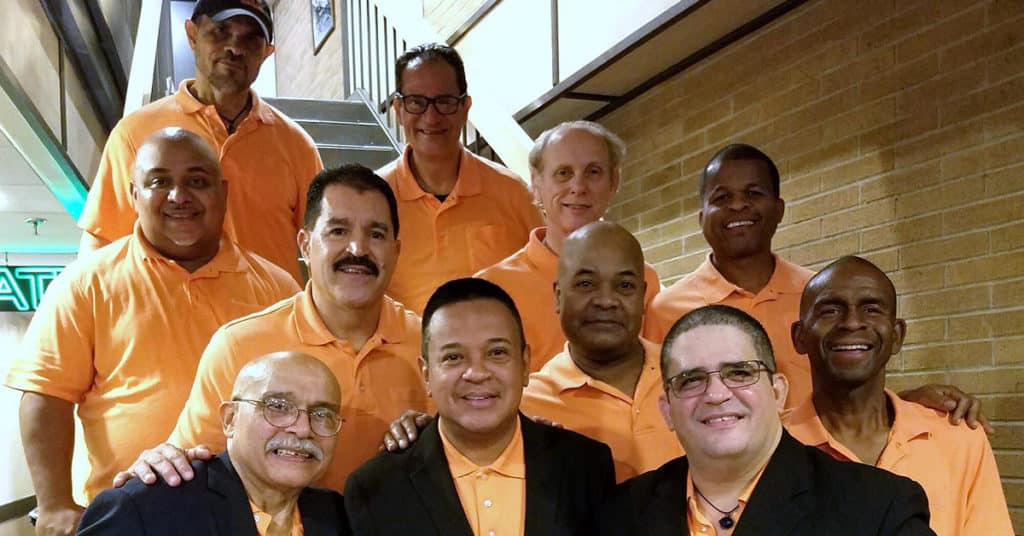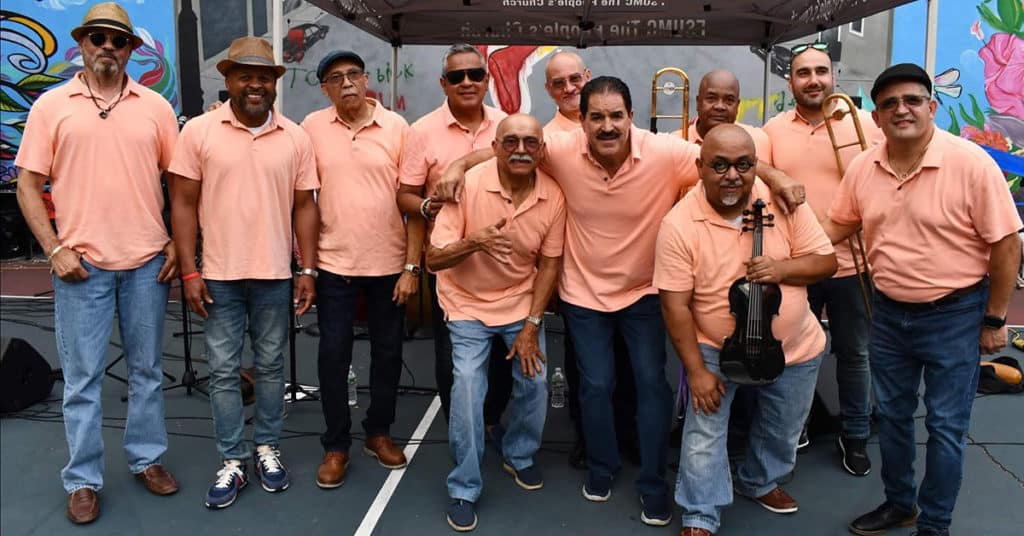Son Del Monte is a New York Puerto Rican “Chanjunto” (Charanga Conjunto) band that plays dance music in the Cuban style of early New York Salsa.
- Son Del Monte plays New York Pachanga (Salsa Cuban Style) at the New York International Salsa Congress at the Marriott Marquis in Times Square on Sunday, September 4, 2022 from 6:30-11pm. From $20. Instagram @newyorksalsacongress 🇨🇺🇵🇷
- Son Del Monte plays New York Pachanga (Salsa) for Carnegie Hall Citywide in the amphitheater at Denny Farrell Riverbank State Park along the Hudson River in Hamilton Heights (West Harlem) on Saturday, August 20, 2022 at 5pm. Free. carnegiehall.org 🇨🇴🇨🇺🇵🇷🇪🇸🇺🇸
Son Del Monte

The band is led by Timbalero and Musical Director Manny Rivera.
The rest of the lineup is:
- Joe Gonzalez, Congas
- Andy Colon, Piano
- Bert Castro, Bass
- Mauricio Smith Jr., Flute
- Eric Salazar, Violin
- Charlie Garcia, Trombone
- Demetrios Kehagias, Trombone
- Luis Soto Jr., Vocals and Guiro
- Luis Ayala, Vocals
- Armando Jimenez, Vocals
Band members come from Colombia, Puerto Rico, Spain and New York. 🇨🇴🇵🇷🇪🇸🇺🇸
In 2018, the band won Taíno Nation Entertainment’s (TANAE) Band of the Year award.
Decoding The Music
In short, Son Del Monte is a Salsa band, but many words can be used to describe the music. Let’s try to break them down.
Son Cubano
Son Cubano is Cuban dance music. It comes from Eastern Cuba around Santiago de Cuba, where a lot of Cuban culture originates.
You can hear the mix of African and Spanish traditions in Son Cubano, but the overall sound tends to be more European than African. Buena Vista Social club is the iconic Son Cubano band.
By the way, there are equivalents in Mother Africa, but in the Caribbean, maracas and the guiro are Indigenous Taíno instruments. ¡WEPA!
In Cuba, Son Cubano evolved into Timba. In New York it evolved into Salsa.
Cuba was long isolated after the Cuban Revolution of 1959. When Cuban musicians first began to hear New York Salsa in the 1970s, they wondered why we were playing their parents’ Son Cubano from the 1950s. Cubans had moved on to Timba.
Del Monte
“Del Monte” literally means from the mountains, but has multiple layers of meaning.
Being from the mountains means it is from the mountain farmers who are widely respected in the Caribbean because they are extremely self-reliant. They are the old time entrepreneurs of el Caribe.
“Del Monte” can be a word play with “Pa’l Monte” which means “to the mountains.”
- In the Caribbean, going to the mountains is something you do with family which triggers wonderful memories.
- It can also mean reaching the heights of spirituality. In African Diaspora tradition, dancing is how we pray and some important saints live in the mountains. Pico Turquino, in Santiago de Cuba Province, is the tallest mountain in Cuba. It has a widely reported mystical character. The same is true for El Yunque in Puerto Rico (home of Yúcahu and where Atabey rises) and Mount Olympus in Greece (home of Zeus, Hera and the Olympians). So the mountains have a spiritual meaning in many human cultures.
Charanga
A Charanga is a Cuban dance band in the 1940s style. It includes European instruments such as the flute and violin.
By the way, the flute in Salsa sounds just like the Caribbean Blackbird (Greater Antillean Grackle which Puerto Ricans call Mozambique or Changó).
Charanga bands play “Pachanga” music. It’s a mixture of Son Cubano and Haitian Méringue (like Dominican Merengue).
During the Haitian Revolution (1791-1804) the Haitian Diaspora spread around the Caribbean to Cuba, Dominican Republic, Puerto Rico, Martinique, Trinidad and New Orleans. They brought musical traditions with them which increased the syncopation in the music.
Jazz is from New Orleans, but it’s really from the Haitian Diaspora because by 1810, half the population of New Orleans was Haitian Diaspora. Once you know how to read the signs, you start to see influences of the Haitian Diaspora all over the Caribbean, and in the USA too.
In New York City, Pachanga is early Salsa.
Conjunto
The Conjunto was a Cuban band of the 1940s that plays Son Cubano.
Arsenio Rodríguez was one of the main architects of the Conjunto. He added piano, congas and trumpets to the standard guitar, tres, bongo and maraca ensemble. He also re-emphasized the African rhythms.
After Arsenio, Son Cubano begins to feel more African again. In a way, he brought the Rumba into Son.
Puerto Ricans have a great respect for Cuban culture. We have our own culture and sound, but are practically Cuba’s little sister (like Yemayá and Oshún). In 1893, Puerto Rican poet Lola Rodríguez de Tió coined the phrase, “Cuba and Puerto Rico are two wings of one bird” in her poem “To Cuba.” Perhaps we recognize ourselves in each other. Anyway, that’s why Puerto Ricans like Tito Puente developed a Cuban sound.
Salsa
In New York City, Johnny Pacheco adopted the Conjunto format in the early 1960s.
Eddie Palmieri’s La Perfecta band added the deep sound of trombones, which later becomes the Fania sound.
In New York City’s Puerto Rican community, all of this mixed with Puerto Rican Bomba and Plena traditions into what we now call Salsa (Salsa Duro, Salsa Gordo or Hard Salsa).
You don’t get Salsa without the Bomba Sicá rhythm (Tum, ta-ta, pa). We noticed that if the Sicá is in the music, Puerto Ricans will dance. It’s in our DNA somehow. Rafael Cortijo, Ismael Rivera, Tommy Olivencia and others put Bomba rhythms into La Salsa. [Editor: we are writing this from their neighborhood, Santurce.]
Johnny Pacheco’s Fania Records went on to define Salsa. Tito Puente stuck with his Cuban sound. Celia Cruz was never allowed to return to Cuba so she popularized the musical blend of Salsa all over the world.
Salsa was created by artists from all over the Caribbean, but it was born in New York City’s Puerto Rican community. It then jumped to Colombia and went global.
Chanjunto

“Chanjunto” is a Charanga band with Conjunto elements. It’s basically early New York Salsa.
Whatever it is, Son Del Monte makes great music for dancing. ¡WEPA! 🇵🇷
Initial coverage was sponsored by Carnegie Hall. Thank you!
